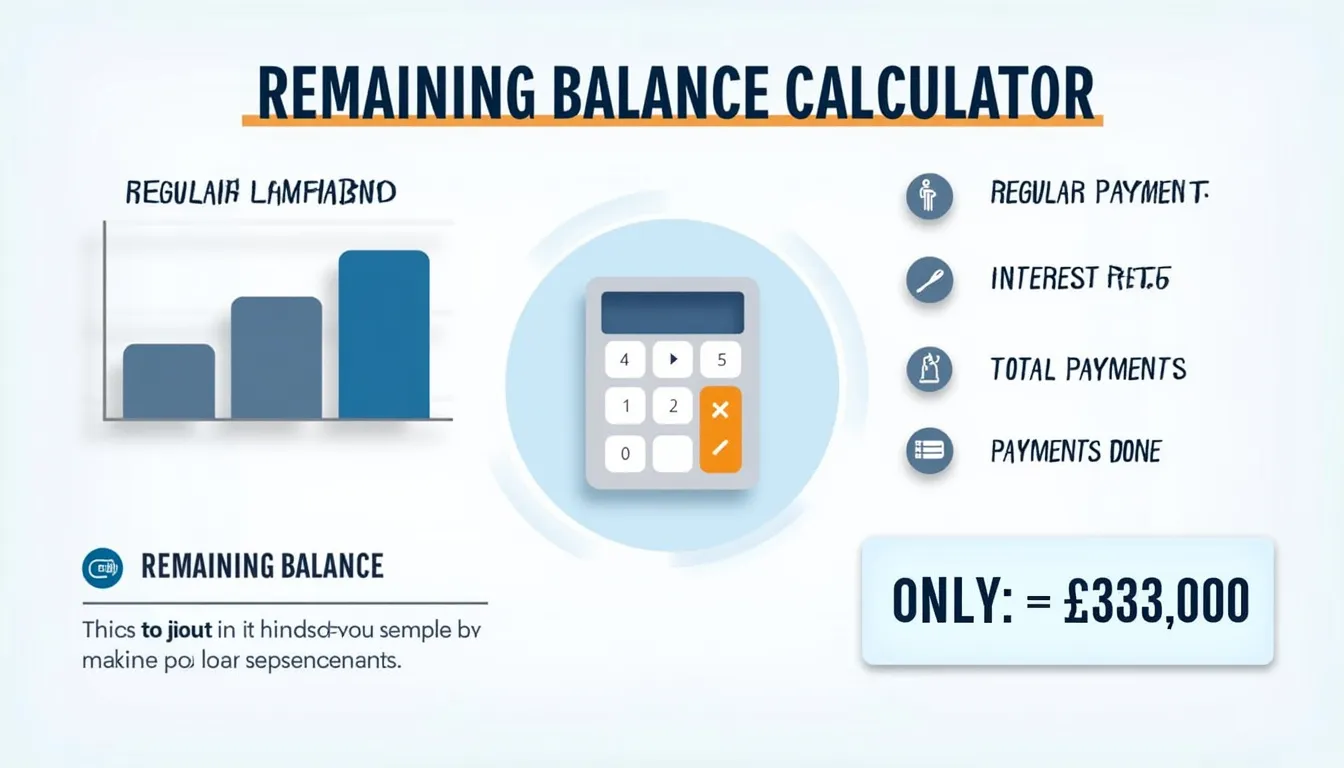Remaining Balance Calculator
Is this tool helpful?
Remaining Balance Calculator: Your Ultimate Tool for Loan Management
How to Use the Remaining Balance Calculator Effectively
Our Remaining Balance Calculator is designed to help you quickly and accurately determine the outstanding balance on your loan after making a certain number of payments. Here’s a step-by-step guide on how to use this powerful tool:
- Enter your regular payment amount in USD.
- Input the interest rate per payment period as a percentage.
- Specify the total number of payments for the loan.
- Indicate the number of payments you’ve already made.
- Click the “Calculate” button to see your remaining balance.
The calculator will instantly process your inputs and display the remaining balance on your loan, giving you valuable insights into your financial situation.
Understanding the Remaining Balance Calculator
The Remaining Balance Calculator is a sophisticated financial tool that helps borrowers, lenders, and financial planners determine the outstanding balance on a loan after a specific number of payments have been made. This calculator takes into account the loan’s regular payment amount, interest rate, total number of payments, and the number of payments already completed to provide an accurate remaining balance figure.
The Mathematics Behind the Calculator
The calculator uses a complex financial formula to determine the remaining balance. The mathematical equation used is:
$$B = P * \frac{1 – (1 + r)^{-(n – p)}}{r}$$Where:
- B = Remaining balance
- P = Regular payment amount
- r = Interest rate per period (as a decimal)
- n = Total number of payments
- p = Number of payments made
This formula takes into account the time value of money, considering both the principal and interest components of each payment.
Benefits of Using the Remaining Balance Calculator
Utilizing our Remaining Balance Calculator offers numerous advantages for individuals managing loans or planning their financial future:
- Financial clarity: Gain a clear understanding of your current loan status and progress towards full repayment.
- Informed decision-making: Use the calculated remaining balance to make strategic decisions about loan refinancing, early repayment, or budget adjustments.
- Time-saving: Quickly obtain accurate remaining balance figures without the need for complex manual calculations.
- Goal setting: Set realistic financial goals based on your current loan status and projected repayment timeline.
- Financial planning: Incorporate the remaining balance information into your overall financial planning strategy.
- Loan comparison: Compare the remaining balances of different loans to prioritize repayments or consolidation efforts.
Addressing User Needs and Solving Specific Problems
The Remaining Balance Calculator addresses several key user needs and solves specific problems related to loan management:
1. Tracking Loan Progress
One of the primary challenges borrowers face is understanding how much progress they’ve made in repaying their loans. The Remaining Balance Calculator solves this problem by providing an accurate, up-to-date figure of the outstanding balance. This information allows users to:
- Visualize their loan repayment progress
- Understand the impact of their regular payments on the loan balance
- Stay motivated by seeing the decreasing balance over time
2. Financial Planning and Budgeting
Effective financial planning requires a clear understanding of one’s current financial obligations. The Remaining Balance Calculator helps users:
- Incorporate accurate loan balance information into their overall financial plans
- Make informed decisions about budget allocations for loan repayments
- Plan for future financial goals while considering existing loan obligations
3. Evaluating Refinancing Options
When considering loan refinancing, knowing the exact remaining balance is crucial. Our calculator helps users:
- Accurately compare their current loan balance with refinancing offers
- Determine if refinancing would be beneficial based on the remaining balance and terms
- Make informed decisions about whether to proceed with refinancing
4. Early Repayment Considerations
For borrowers considering early loan repayment, the Remaining Balance Calculator provides valuable insights:
- Understand the exact amount needed to pay off the loan in full
- Evaluate the potential savings on interest by making early repayments
- Plan for lump-sum payments or increased regular payments to accelerate loan repayment
5. Loan Consolidation Analysis
When considering consolidating multiple loans, knowing the remaining balance on each loan is essential. Our calculator helps users:
- Accurately determine the total remaining balance across all loans
- Compare individual loan balances to prioritize consolidation efforts
- Make informed decisions about which loans to include in a consolidation plan
Practical Applications and Use Cases
To illustrate the practical applications of the Remaining Balance Calculator, let’s explore some real-world scenarios:
1. Mortgage Refinancing Evaluation
Sarah has been paying her 30-year mortgage for 5 years and is considering refinancing options. Using the Remaining Balance Calculator, she inputs the following information:
- Regular Payment: $1,500
- Interest Rate: 4.5% (0.375% per month)
- Total Number of Payments: 360 (30 years * 12 months)
- Number of Payments Done: 60 (5 years * 12 months)
The calculator reveals that Sarah’s remaining balance is approximately $268,721. Armed with this information, she can now accurately compare refinancing offers and determine if they would provide significant savings based on her current loan balance.
2. Student Loan Repayment Planning
Mark is a recent graduate with multiple student loans. He wants to create a repayment strategy and needs to know the remaining balance on each loan. For one of his loans, he enters the following details:
- Regular Payment: $350
- Interest Rate: 6% (0.5% per month)
- Total Number of Payments: 120 (10 years * 12 months)
- Number of Payments Done: 24 (2 years * 12 months)
The calculator shows that the remaining balance on this particular loan is approximately $29,842. Mark can repeat this process for each of his loans, allowing him to prioritize payments and consider consolidation options based on the remaining balances.
3. Car Loan Early Payoff
Emily is considering paying off her car loan early and wants to know how much she still owes. She inputs the following information into the Remaining Balance Calculator:
- Regular Payment: $400
- Interest Rate: 3.6% (0.3% per month)
- Total Number of Payments: 60 (5 years * 12 months)
- Number of Payments Done: 36 (3 years * 12 months)
The calculator reveals that Emily’s remaining balance is approximately $9,523. With this information, she can decide whether to allocate extra funds to pay off the loan early or continue with the regular payment schedule.
4. Business Loan Analysis
John, a small business owner, wants to assess his company’s financial health by determining the remaining balance on a business loan. He enters the following details:
- Regular Payment: $2,500
- Interest Rate: 7.2% (0.6% per month)
- Total Number of Payments: 84 (7 years * 12 months)
- Number of Payments Done: 48 (4 years * 12 months)
The calculator shows that the remaining balance on the business loan is approximately $76,892. This information helps John assess his company’s debt obligations and plan for future financial decisions.
Frequently Asked Questions (FAQ)
1. How accurate is the Remaining Balance Calculator?
The Remaining Balance Calculator uses a standard financial formula to provide highly accurate results. However, the accuracy depends on the precision of the input data. For the most accurate results, ensure that you enter the correct regular payment amount, interest rate, total number of payments, and number of payments made.
2. Can I use this calculator for any type of loan?
Yes, the Remaining Balance Calculator can be used for various types of loans, including mortgages, auto loans, personal loans, and student loans. As long as you have the required input information, you can calculate the remaining balance for any amortizing loan.
3. What if my loan has a variable interest rate?
For loans with variable interest rates, the calculator provides an approximation based on the current interest rate. Keep in mind that future changes in the interest rate will affect the actual remaining balance. For the most accurate results, recalculate the remaining balance whenever the interest rate changes.
4. How often should I recalculate my remaining balance?
It’s a good practice to recalculate your remaining balance periodically, especially after making significant changes to your loan, such as extra payments or refinancing. For most borrowers, checking the remaining balance quarterly or semi-annually is sufficient to stay informed about their loan progress.
5. Can this calculator account for extra payments or lump-sum payments?
The basic version of this calculator doesn’t directly account for extra payments or lump-sum payments. However, you can adjust the “Number of Payments Done” to reflect the impact of additional payments on your loan progress. For a more precise calculation that includes extra payments, you may need a more advanced loan calculator.
6. Is the remaining balance the same as the payoff amount?
The remaining balance calculated by this tool may be close to, but not exactly the same as, the payoff amount. The payoff amount might include additional fees or daily interest accrual. For an exact payoff amount, contact your lender directly.
7. Can I use this calculator for loans in currencies other than USD?
Yes, you can use this calculator for loans in any currency. The calculation is based on the numerical values entered, regardless of the currency. Just make sure all your inputs are in the same currency for consistent results.
Please note that while we strive for accuracy and reliability, we cannot guarantee that the results from our webtool are always correct, complete, or reliable. Our content and tools might have mistakes, biases, or inconsistencies. Always consult with a financial professional for important financial decisions.
Conclusion: Empowering Your Financial Journey
The Remaining Balance Calculator is an invaluable tool for anyone managing loans or planning their financial future. By providing quick and accurate calculations of your outstanding loan balance, this calculator empowers you to:
- Track your loan repayment progress with precision
- Make informed decisions about refinancing, early repayment, or loan consolidation
- Incorporate accurate loan information into your overall financial planning
- Set realistic financial goals based on your current loan status
- Gain a clearer understanding of your financial obligations and progress
By leveraging the power of this calculator, you can take control of your loan management process and make more informed financial decisions. Whether you’re a homeowner, student loan borrower, or business owner, the Remaining Balance Calculator provides the insights you need to navigate your financial journey with confidence.
Take the first step towards better loan management today. Use our Remaining Balance Calculator to gain valuable insights into your financial situation and make informed decisions about your future. Your path to financial clarity and success starts here!
Important Disclaimer
The calculations, results, and content provided by our tools are not guaranteed to be accurate, complete, or reliable. Users are responsible for verifying and interpreting the results. Our content and tools may contain errors, biases, or inconsistencies. We reserve the right to save inputs and outputs from our tools for the purposes of error debugging, bias identification, and performance improvement. External companies providing AI models used in our tools may also save and process data in accordance with their own policies. By using our tools, you consent to this data collection and processing. We reserve the right to limit the usage of our tools based on current usability factors. By using our tools, you acknowledge that you have read, understood, and agreed to this disclaimer. You accept the inherent risks and limitations associated with the use of our tools and services.







